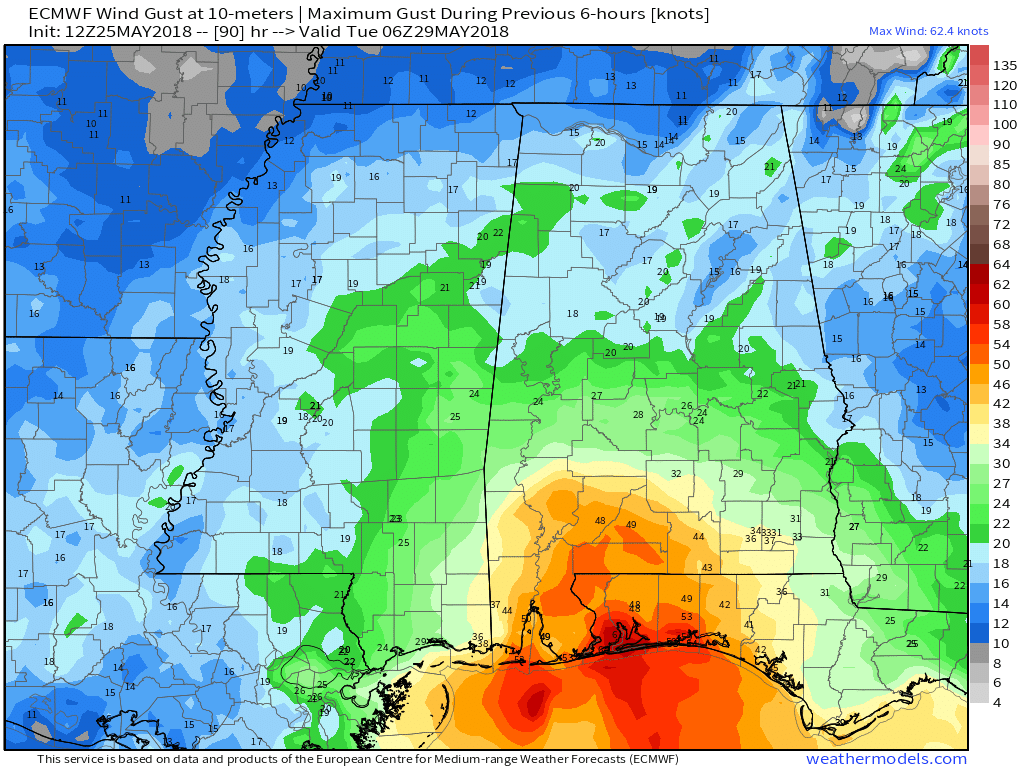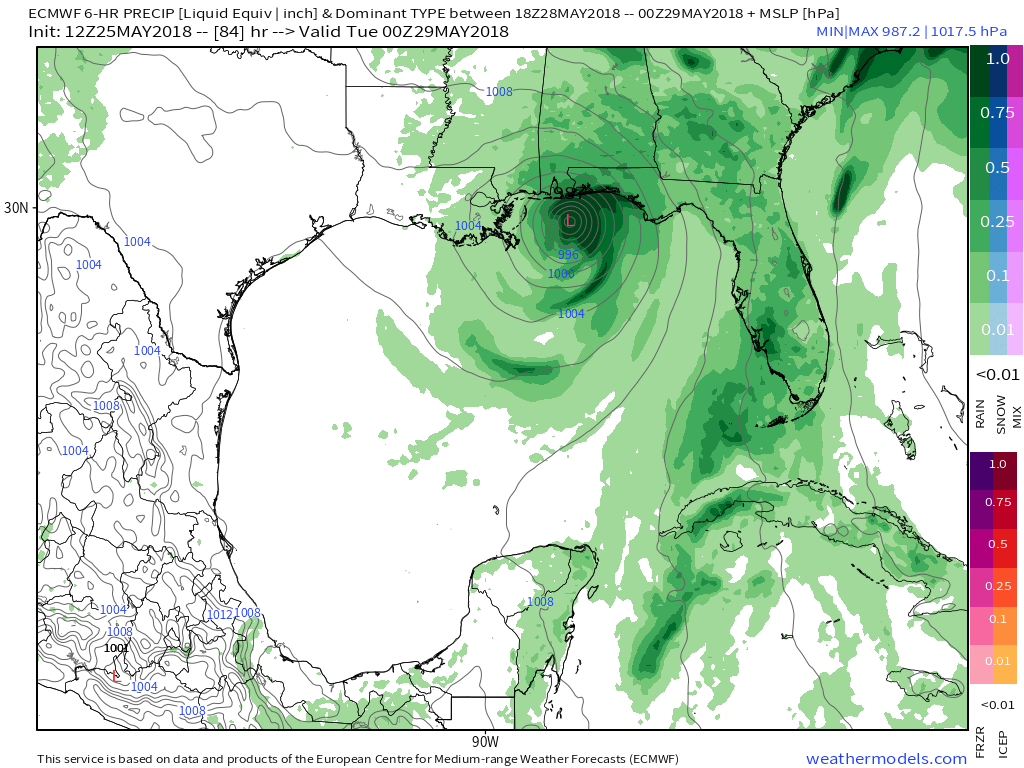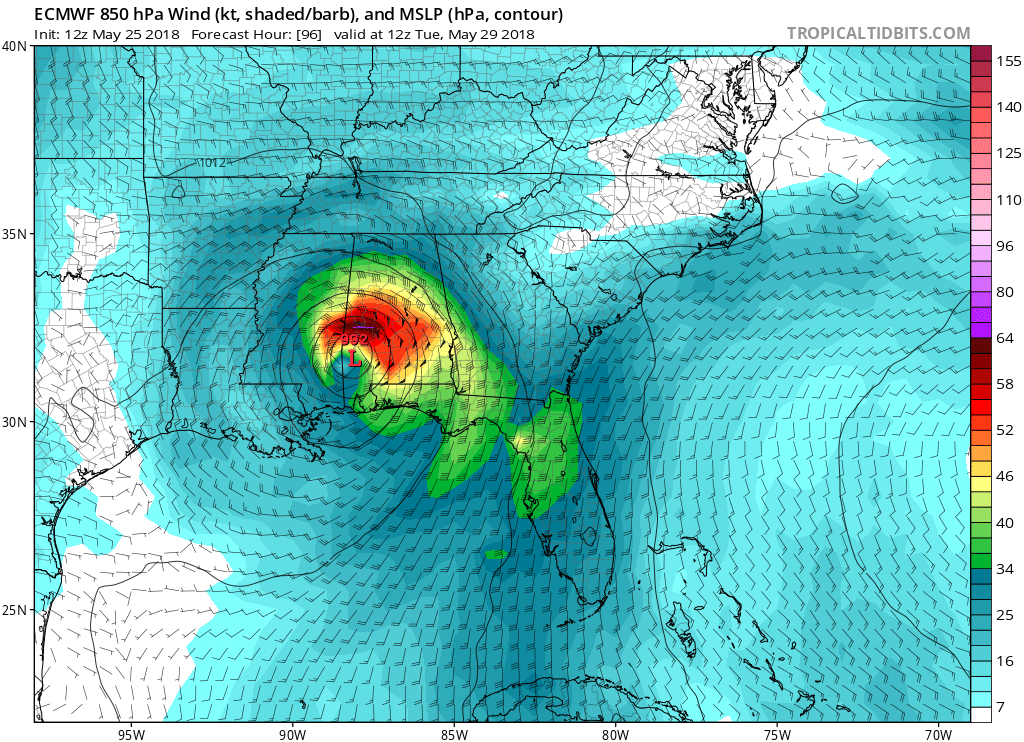000
WTNT41 KNHC 251444
TCDAT1
Subtropical Storm Alberto Discussion Number 1
NWS National Hurricane Center Miami FL AL012018
1000 AM CDT Fri May 25 2018
The broad low pressure system that the NHC has been tracking for
the past several days over the Yucatan Peninsula has finally moved
offshore over the waters of the northwestern Caribbean Sea.
Although the system possesses multiple low-level circulations, the
overall larger circulation has improved since yesterday. Given that
the system has been interacting with a sharp upper-level trough,
the strongly sheared low has been designated a subtropical storm.
The initial intensity is based on buoy and ship observations of
30-35 kt. Ship 3ETA7 located just northeast of the center at 1100Z
reported 45-kt winds at 50 meters elevation. Those winds equate to
35-40 kt at 10 meters elevation. An Air Force Reserve Hurricane
Hunter Aircraft is scheduled to investigate Alberto later this
afternoon and provide more information on the storm's structure and
intensity.
The initial motion estimate is an uncertain 020/05 kt. The broad
inner-core wind field and multiple swirls makes the short-term
motion forecast a little tricky. However, a large subtropical ridge
to the east should generally induce a slow north to north-
northeastward motion for the next 24 hours or so. After that, the
ridge across the western Atlantic and Florida, along with a
mid/upper-level low forecast to develop over the central Gulf of
Mexico, should result in a faster northward motion at 36-48 hours,
followed by a gradual turn toward the northwest around the
northern fringe of the aforementioned mid/upper-level low. By 96
hours, the cyclone is forecast to slow down significantly as it
nears the north-central Gulf Coast due to a large weakness in the
subtropical ridge forecast to develop over the Deep South. The
official forecast track closely follows the consensus models TVCN
and HCCA.
Given the broad inner-core wind field and belligerent westerly wind
shear forecast to persist for the next 48 hours or so, only gradual
intensification is expected. By 72 hours, however, when the cyclone
is forecast to move slowly over above-normal SSTs of 28-29C and into
an upper-level col and weak wind shear, some additional
strengthening could occur. For now, the intensity forecast will
remain conservative due to possible intrusion of dry mid-level air
before landfall, and closely follows the HCCA consensus model.
KEY MESSAGES:
1. Regardless of its exact track and intensity, Alberto is expected
to produce heavy rainfall and flash flooding over the northeastern
Yucatan Peninsula of Mexico, western Cuba, southern Florida and the
Florida Keys. Rainfall and flooding potential will increase across
the central Gulf Coast region and the southeastern United States
later this weekend and early next week when Alberto is expected to
slow down after it moves inland.
2. Alberto could bring tropical storm conditions and storm surge to
portions of the central and eastern Gulf Coast later this weekend
and early next week, although it is too soon to specify the exact
location and magnitude of these impacts. Residents in these areas
should monitor the progress of Alberto, as tropical storm and storm
surge watches may be required later today or tonight.
3. Dangerous surf and rip current conditions are affecting portions
of the Yucatan Peninsula and western Cuba and will likely spread
along the eastern and central U.S. Gulf Coast later this weekend.
FORECAST POSITIONS AND MAX WINDS
INIT 25/1500Z 19.7N 86.8W 35 KT 40 MPH
12H 26/0000Z 20.5N 86.6W 35 KT 40 MPH
24H 26/1200Z 22.0N 86.2W 40 KT 45 MPH
36H 27/0000Z 24.1N 85.8W 45 KT 50 MPH
48H 27/1200Z 26.7N 86.1W 50 KT 60 MPH
72H 28/1200Z 29.3N 87.9W 55 KT 65 MPH
96H 29/1200Z 31.0N 89.1W 30 KT 35 MPH...INLAND
120H 30/1200Z 33.6N 88.7W 20 KT 25 MPH...INLAND
$$
Forecaster Stewart









